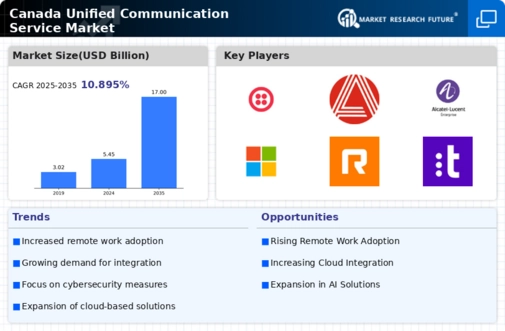The unified communication-service market in Canada is characterized by a dynamic competitive landscape, driven by rapid technological advancements and an increasing demand for integrated communication solutions. Major players such as Microsoft (US), Cisco (US), and Zoom (US) are at the forefront, each adopting distinct strategies to enhance their market presence. Microsoft (US) focuses on continuous innovation within its Teams platform, integrating AI capabilities to streamline workflows and improve user experience. Cisco (US), on the other hand, emphasizes strategic partnerships and acquisitions to bolster its portfolio, particularly in cloud-based services. Zoom (US) has been expanding its offerings beyond video conferencing, venturing into areas like team collaboration and customer engagement, thereby diversifying its operational focus. Collectively, these strategies contribute to a competitive environment that is increasingly centered around technological integration and user-centric solutions.
Key business tactics employed by these companies include localizing services to meet regional demands and optimizing supply chains to enhance service delivery. The market structure appears moderately fragmented, with several key players exerting influence while also facing competition from emerging firms. This fragmentation allows for a variety of service offerings, catering to diverse customer needs and preferences, which in turn fosters innovation and competitive pricing.
In October 2025, Microsoft (US) announced a significant upgrade to its Teams platform, incorporating advanced AI features aimed at enhancing productivity and collaboration. This strategic move not only reinforces Microsoft’s commitment to innovation but also positions it as a leader in the integration of AI within communication services. The upgrade is expected to attract new users and retain existing customers by providing enhanced functionalities that streamline communication processes.
In September 2025, Cisco (US) completed the acquisition of a prominent cloud communications provider, which is anticipated to expand its capabilities in delivering comprehensive communication solutions. This acquisition underscores Cisco's strategy to enhance its cloud offerings and strengthen its competitive position in the market. By integrating the acquired technologies, Cisco aims to provide a more robust and versatile service portfolio, catering to the evolving needs of businesses.
In August 2025, Zoom (US) launched a new suite of tools designed for hybrid work environments, focusing on seamless integration between in-person and virtual interactions. This initiative reflects Zoom's strategic pivot towards addressing the changing dynamics of workplace communication. By offering tailored solutions for hybrid work, Zoom is likely to enhance its market share and solidify its reputation as a versatile communication platform.
As of November 2025, current trends in the unified communication-service market include a pronounced shift towards digitalization, sustainability, and the integration of AI technologies. Strategic alliances among key players are increasingly shaping the competitive landscape, fostering innovation and collaborative solutions. Looking ahead, competitive differentiation is expected to evolve, with a greater emphasis on technological advancements and supply chain reliability rather than solely on price. This shift indicates a maturation of the market, where innovation and customer-centric solutions will likely dictate success.



















Leave a Comment